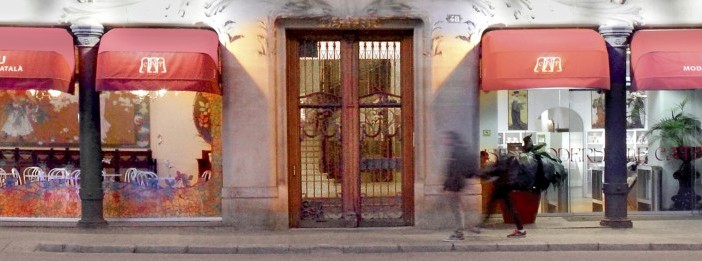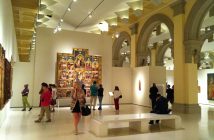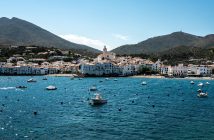The only museum in Europe to specialise in Catalan Modernism, the MMBCN (Museu del Modernisme de Barcelona) opened its doors in March 2010 in the centre of the Catalan capital, focusing on presenting key works of art from the Modernist movement throughout Catalonia.
Origins
To understand the origins of this museum we must go back to the 1970’s, to the marriage of antique collectors Fernando Pinós and Maria Guiaro, which inspired a deep passion and devotion to modern art, throughout which they started to build their art collection, accumulating a great selection of pieces with tremendous artistic importance and unrivalled history. Their journey was challenging, as at this time all modernist expression was considered unfathomable and insulting. Many modernist buildings were discarded or demolished, and their art sold as mere elements of the past, falling into an artistic oblivion. There existed scarcely any studies or investigations into the era, which made this project hard but unique; now a proud object of admiration in the international art circuit.
Currently, the specialization and the rigor of these investigations into Modernism has succeeded in placing Modernism and its manifestations in the historic and cultural positioning that it deserves, constituting one of the most characteristic symbols of Catalan identity. The intentions of the couple to revitalize the movement, their pioneering work in this field and their vocation to spread the work throughout the public compelled them to display their passion for modern art in the form of a museum, the Museu del Modernisme de Barcelona, a permanent collection allowed to be enjoyed by everyone.
Architecture
The museum itself is located in the centre of the Ensanche quarter of Barcelona, in a Modernist building erected in 1902, constructed by the architect Enric Sagnier. The location constitutes a perfect historic-cultural link, as the building is located in a neighbourhood focussed on Modernism itself. Many of the buildings in this district, including the museum, are important historic and aesthetic testimonies to the excellent artistic era. Close to both Passeig de Gracia and Rambla de Cataluña, where numerous buildings from prestigious architects from the era are located, such as Antoni Gaudí, Lluís Domenèch i Montaner and Josep Puig i Cadafelch, the museum has on display several objects and works of art that decorate the interiors of these emblematic Catalan houses. The architect Enric Sagnier i Vilavecchia is the most prolific architect of the era, with more than 300 buildings documented both in and out of Catalonia. He dedicated his whole life to architecture, and worked on all kinds of buildings, from private houses and public buildings to churches, factories and hotels. His style revolutionized the start of the century from classicism to modernism, breathing life and modernity into numerous houses throughout Ensanche.
Modernism in Catalonia
Modernism was an international movement that originated in Europe at the end of the 19th century, with foundations in aesthetics, the renewal of arts and constant inspirations in nature. The movement evolved differently country by country, as a result of different cultural specific influences. It’s important to see that each country enjoyed a distinct style of Modernism, even though they hold stylistic similarities. In Catalonia, the movement wasn’t only aesthetic, but extended beyond that, becoming one of the most politically charged areas in terms of Modernism. The new type of art brought forth lots of symbols, as well as proposing more creative freedom, not previously accepted by academic institutions.
The Collection
The MMBCN boasts an exhibition area of 1,000 square metres. On the ground floor of the museum mainly furnishings from the modernist era are found, like cabinets, dining tables, office furniture, wardrobes, ceramics, and other carefully designed artistic everyday items. From this floor it is made clear why the modernist era was mainly a middle class Bourgeoisie period, as regardless of their use, all items are so intricately designed, amounting to a small fortune. Here you will also find furniture of designer and architect Antoni Gaudí, one of the most influential and recognised representatives of Modernism. The museum has an area especially dedicated to him, displaying decorations from his famous houses such as Casa Calvet, Casa Mila and Casa Batlló. Further into the museum you will discover the cellar of this former factory building, housing the painting and sculpture collection, exhibiting works from some of the most influential Modernist painters – including Ramon Casa, Santiago Rusiñol and Joaquim Mir i Trinxet, all artists boasting great modernist art works. Major sculptures are exhibited by both Josep Llimona and Eusebi Anrnau, a sculptor also involved in the building of the acclaimed Palau de la Musica and the Hospital de la Santa Creu i de Sant Pau.
The collection contains over 350 works by 42 artists ranging from paintings and sculptures to furniture and decorative arts.
Details
Website: http://www.mmbcn.cat/
Rates and admission: http://www.mmbcn.cat/en/opening-times-and-admission/
Address and contact information:
Calle Balmes, 48
08007 Barcelona
Tel.: +34 932 722 896
mmbcn@mmbcn.cat




